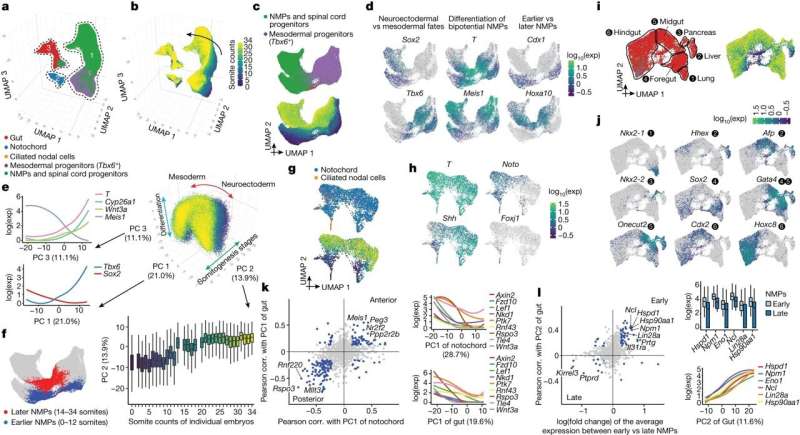This article has been reviewed according to Science X's editorial process and policies. Editors have highlighted the following attributes while ensuring the content's credibility:
fact-checked
trusted source
proofread
Mouse study finds birth coincides with rapid changes in gene activity

During its gestation, the house mouse starts out as a single fertilized cell and three weeks later is ready to enter the world as a free-living pup composed of more than 500 million cells.
Scientists are eager to understand how the genome of the house mouse, Mus musculus, orchestrates this routine yet astounding transformation. Although its pregnancies are much shorter, the mouse shares many evolutionary commonalities with humans. It not only offers a useful scientific model of mammalian prenatal development, but also might reveal some basics of what happens during human pregnancies.
It has been difficult, however, to determine the gene activities that drive the timing and appearance of the hundreds of cell types that form a complete newborn mouse, with all its parts in the right place. Due in part to this vast number of cells, the genetic movers of mouse early embryonic development previously have been sampled coarsely at fairly long intervals, such as day to day observations.
New techniques allow scientists to profile better what is going on genetically in the nuclei—control centers inside individual cells—at shorter, precise intervals and for a total of more than 12 million cells in 83 mouse embryos. This has enabled them to obtain, at the single-cell level, an improved, annotated time-lapse of mouse prenatal development.
Their analysis began when each embryo first shaped itself into a multilayer structure, the gastrula, and continued through birth.
Their findings are published in the journal Nature. The lead authors of the paper are Chenqxiang Qiu and Beth K. Martin of the Department of Genome Sciences at the University of Washington School of Medicine in Seattle and Ian C. Welsh of The Jackson Laboratory in Bar Harbor, Maine.
The scientists wrote that they hope their deep sampling will aid "progress towards a more comprehensive, continuous view of transcriptional dynamics throughout prenatal development."
Transcriptional dynamics refers to the timing of cells reading and acting on the plans contained in various parts of their genomes. This time-sensitive activity is vital to producing proteins that guide, for example, the creation and migration of the kinds of cells required at each stage of embryonic development.
The scientists applied a method called optimized single-cell combinatorial indexing RNA sequencing (sci-RNA-seq) to determine the transcriptional states of cells at two- to six-hour intervals from eight days into prenatal development until birth. From this information, the researchers were able to annotate hundreds of cell types and explore the formation of the kidneys, retina, early neurons, and other tissues.
Combining this latest information with other published data available through open science, the researchers constructed a tree outlining the cell-type lineages and relationships across mouse prenatal development, from the fertilized egg to the newborn pup. Within this tree, they also suggested which genes might be at work in the living, developing embryo to pilot the emergence of hundreds of cell types.
Immediately after the birth of their mouse pups, the scientists noticed that massive, abrupt transcriptional changes had occurred in the nuclei of several kinds of cells, such as those in the airway, liver, and fat tissue. The scientists speculated that these changes might be physiologically necessary due to the profound disruption that occurs between life connected to a placenta and life outside the womb.
A newborn pup suddenly needs to breathe air, maintain normal sugar levels after being cut off from its mother's nutrients, and keep its body at the right temperature. However, many more genes whose adaptive function shortly after birth is not yet known also were turned up. What this means is open for exploration.
The transition from the womb to the outside world, the scientists noted, is already recognized as "fraught with physiological peril."
The researchers added that the kinetic patterns for the rapid transcriptional changes during birth were much more complex than originally realized and that some might pertain to vaginally birthed pups compared to those delivered by C-section.
In discussing their study, the researchers explained that their goal "was not to learn a specific piece of biology, but rather to advance the foundation for a comprehensive understanding of mammalian development." They added that the dataset examined in this study "is a rich source of hypothesis," such as suggesting transcription factors that might drive the emergence of all prenatal cell types.
The researchers also hope that studies such as these will offer a global framework for studying the genomic basis of mammalian development—perhaps even to include postnatal milestones. A single-cell time-lapse of genetic mechanisms at work throughout the entire mammalian lifespan, from conception to demise, might be the ultimate goal of research of this nature.
More information: Chengxiang Qiu et al, A single-cell time-lapse of mouse prenatal development from gastrula to birth, Nature (2024). DOI: 10.1038/s41586-024-07069-w


















